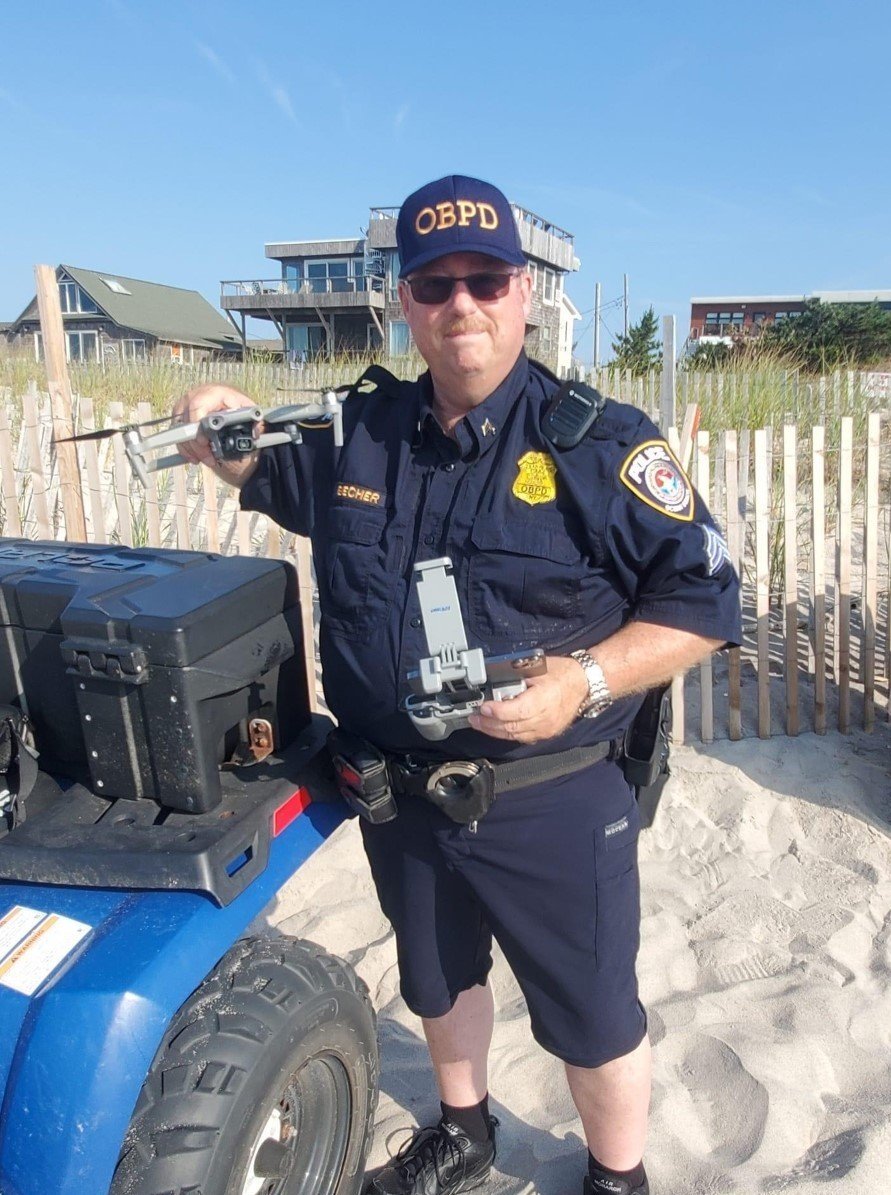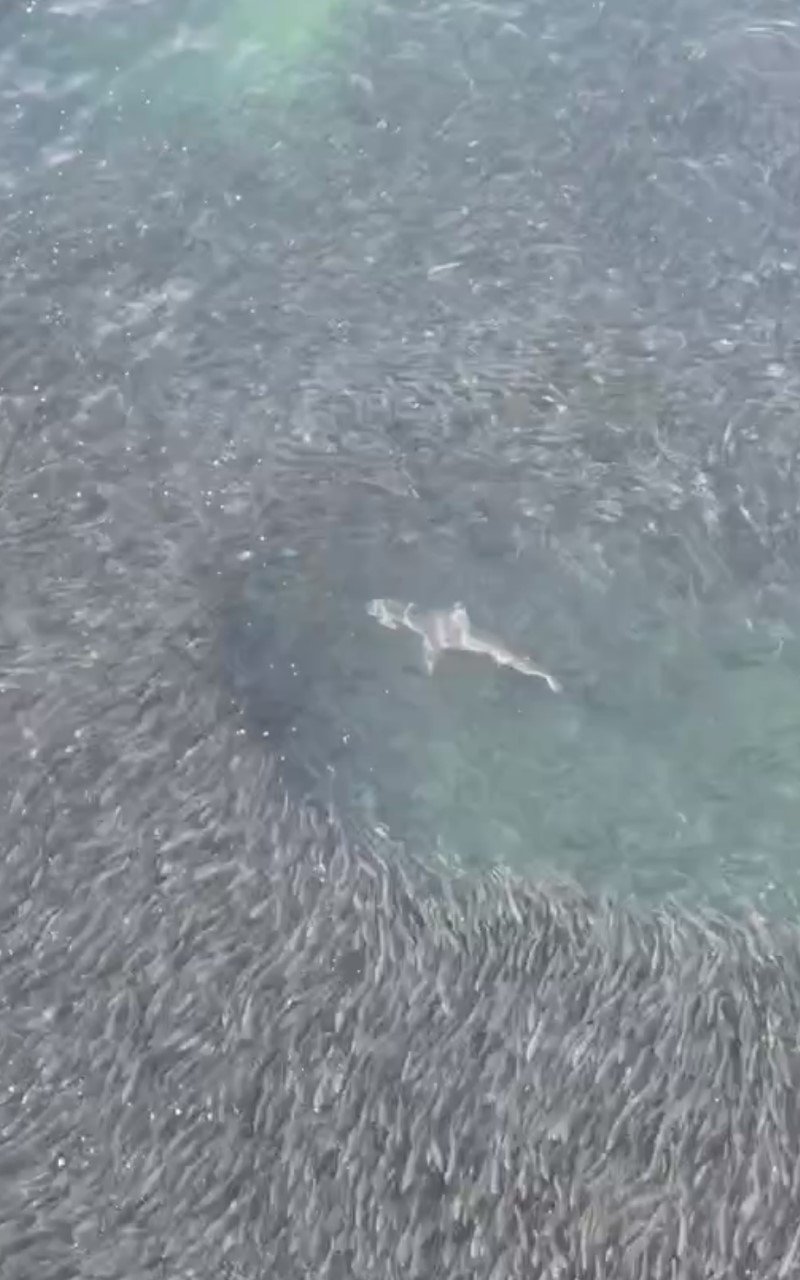Ocean Beach lifeguards and police are ramping up their shark surveillance with drone technology due to the increase in shark-related incidences this summer. The footage captured by the drone will help to promote public safety so Fire Islanders can continue enjoying the ocean.

The new initiative is spearheaded by Andrew Becher, a sergeant with the Ocean Beach Police Department (OBPD). Becher’s years as a lifeguard, experience in aviation as a private pilot and a drone pilot qualified him as the ideal candidate to launch this new program. Alongside the lifeguards, Becher began flying the drone on July 14 across the shore and waters of Ocean Beach to identify hazardous marine life.
“I’m looking for things such as bait fish the sharks may be interested in and any sightings of fin activity that may be a little bit difficult to spot from the lifeguard tower or from the shore,” Becher said. “I am able to fly the drone and positively identify that it is a dolphin, shark, ray or some of the other sea life that is out there.”
Lifeguards are always on the lookout for signs of dangerous marine life and will even take a jet ski out to the water to check suspicious activity. Becher’s drone will further assist with shark surveillance by obtaining accurate and closer visuals. There is a radio frequency connection from the controller to the drone, allowing the videos and images to stream back to the phone. Becher can then make a visual identification and share the information with the lifeguards.
“The use of the drones helps us keep track of what’s out there in real time and keep people from encountering any kind of hazards,” Becher said.
Becher’s drone helps the OBPD and lifeguards observe the movements of sharks’ food source, bunker fish, as it can point to a shark nearby. The drone can spot the bunker schools further into the ocean than is visible from shore, which notifies lifeguards to be more cautious and alert if the prey is nearby. Up to this point, the drone has visually identified thresher and sand tiger sharks, which are known to be in Long Island’s waters.
The drone is flown approximately three times a day. Becher launches it in the morning while the lifeguards are opening the beach and working out, around lunchtime and before 5 p.m. when the lifeguards close the beach. This ensures the police and lifeguards are up to date on the movements and locations of marine life as the day goes on. If any hazardous marine life is identified, lifeguards may close the beach until it is safe to resume swimming.
“A lot of the feeding events that we do spot, the lifeguard will act on it and clear the water,” Becher said. “When the bunker and feeding events pass by, they will certainly reopen the beach and we can confirm any suspicions by using the drone.”

The drone is strictly for observation precaution as sharks will not be physically tagged for tracking. The footage is not currently published digitally for the public to track the movements of sharks and their prey, but beachgoers can stay up to date by asking the lifeguards. Purple flags with an image of a shark is an indicator to bathers and staff members that there were incidences of hazardous marine life recently in the area.
While Becher is focusing on patrolling Ocean Beach, staff and agencies from all over New York are implementing drone technology to increase public safety. Governor Kathy Hochul announced heightened patrols and shark surveillance with drones and helicopters at Long Island State Beaches, such as Robert Moses and Jones Beach.
“As New Yorkers and visitors alike head to our beautiful Long Island beaches to enjoy the summer, our top priority is their safety,” Governor Hochul said in a press conference. “We are taking action to expand patrols for sharks and protect beachgoers from potentially dangerous situations. I encourage all New Yorkers to listen to local authorities and take precautions to help ensure safe and responsible beach trips this summer.”
Alongside Hochul, the New York State Department of Environmental Conservation advised swimmers with shark safety tips such as avoiding areas with seals, schools of bait fish, murky water, swimming alone and swimming dusk or nighttime. When in doubt, always stay close to the shore and adhere to all signage on the beach.
The rise in sharks is a popular topic this summer, but it is largely caused by successful conservation efforts. This means swimmers must learn how to coexist with a healthier ecosystem, which is possible with updated technology such as the drones. While the purple flags or drones buzzing above in the sky may be alarming, it is a sign that Fire Island’s waters are gaining back their diversity and health.
“I’ve been working for the village for 32 years,” Becher said. “It’s nice to see the variety of sea life coming back.”




























